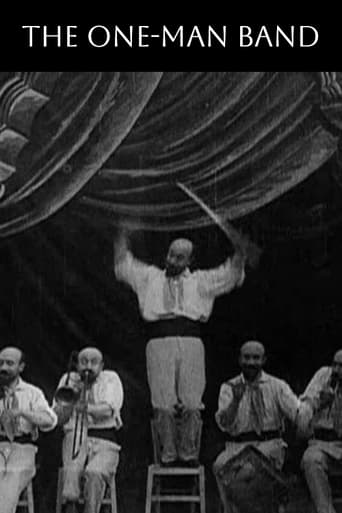

There are seven chairs lined up on stage. A man (Melies) fills on, and then reproduces himself and fills the next, and so on. Each of the incarnations has a musical instrument. First they play in a conventional way, but eventually they will merge and become one man again. There is some clever reshuffling on the stage. One of the better ones.
... View More"The One-Man Band" is one of early cinema pioneer Georges Méliès's more amusing and ingenious trick film attractions. It exploits multiple-exposure photography (a.k.a. superimpositions), which he had already employed in some of his earlier trick films, including "The Four Troublesome Heads" (1898) and "The Mysterious Portrait" (1899). There is also some substitution splicing (a.k.a. stop substitutions), which was Méliès's most common trick. In this film, he uses multiple-exposure photography to reproduce his own image sevenfold—to create a band, who then play their various instruments in an amusingly hammy manner. To accomplish this feat took precise acting and direction from Méliès, as well as from his cameraman; camera masks were used and exact timing was required for the seven different exposures of the negative. It was all done in-camera. As indication of the sophistication of Méliès's trick here, Buster Keaton has received praise for technical and creative brilliance by doing the same thing 21 years later in "The Playhouse".
... View MoreOne of the visual effects that French "Cinemagician" Georges Méliès pioneered and mastered was the double exposure, in which a piece of film is exposed twice, to two different images. The resulting photographic image shows the second image superimposed over the first. 'L' Homme orchestre' is, for its time, a rather advanced experiment into his effect, and, rather than just two images captured together, Méliès has created seven clones of himself, each posing as the various members of an orchestra. As the first magician/musician eases himself onto the first chair, another semi-transparent double rises from his body to occupy the second chair, and so forth.After the enthusiastic "one-man band" has performed a musical piece, they sequentially dissolve into one another, leaving only the conductor of the orchestra, who hangs around for one final display of magic. As a large fan emerges behind him (apparently to his complete surprise, as Méliès demonstrates one of those classic silent comedy double-takes), the conductor takes a seat on the single remaining chair, which sinks into the floor. Quick as a flash, a semi-transparent Méliès comes hurtling from behind the fan, disappearing on impact with the floor with one of those whiz-bang puffs of smoke that the director so adored. The huge fan lowers again to reveal a smugly-grinning Méliès standing there, safe and well.More than a century after it was produced, 'L' Homme orchestre,' though not popularly known among most people, is notable in its innovative use of a newly-discovered visual effect, and as a brief demonstration of Georges Méliès' boundless creativity and enthusiasm. If you've got a couple of minutes of spare time, why not occupy yourself by watching this enjoyable little film?
... View MoreDirector Méliès later went on to make several other shorts where he acted and replicated himself (in two cases, popping off his head and using it to make a whole bunch of singing heads), but I think this is one of the earliest of this type of film (the first coming in 1898). But, instead of pulling off his head, he is able replicate himself many times until he is an entire performing ensemble. While compared to later trick cinematography this isn't a great special effect, for its day it was amazing and quite funny. For a similar type experience (though of course a lot better because of advancements in camera-work), see Buster Keaton's THE PERFORMANCE--where he not only plays all the performers, but all the members of the audience (including the women)!If you want to see this film online, go to Google and type in "Méliès" and then click the video button for a long list of his films that are viewable without special software.
... View More